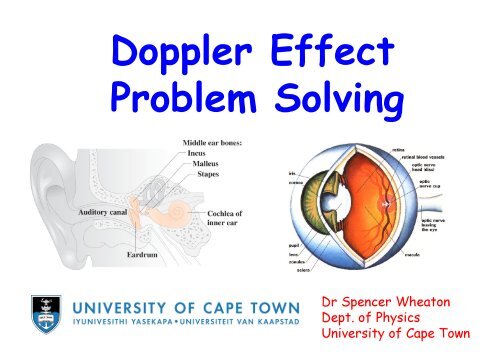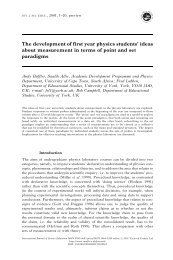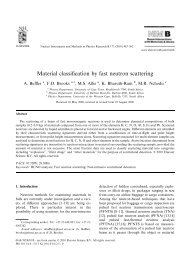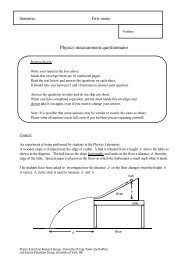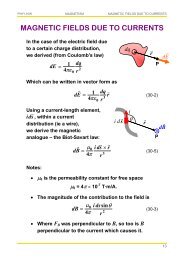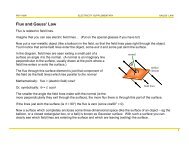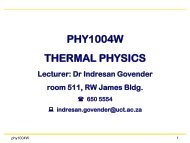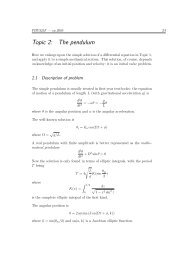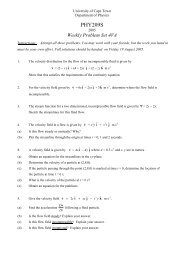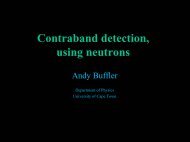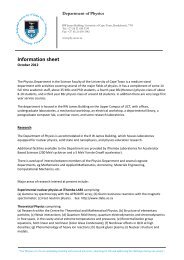Doppler Effect Problem Solving - University of Cape Town
Doppler Effect Problem Solving - University of Cape Town
Doppler Effect Problem Solving - University of Cape Town
Create successful ePaper yourself
Turn your PDF publications into a flip-book with our unique Google optimized e-Paper software.
<strong>Doppler</strong> <strong>Effect</strong><br />
<strong>Problem</strong> <strong>Solving</strong><br />
Dr Spencer Wheaton<br />
Dept. <strong>of</strong> Physics<br />
<strong>University</strong> <strong>of</strong> <strong>Cape</strong> <strong>Town</strong>
What is the <strong>Doppler</strong> <strong>Effect</strong>?<br />
Sound:<br />
“A change in frequency heard by a<br />
listener due to relative motion between<br />
the sound source and the listener”<br />
Light:<br />
“A change in colour seen by an observer<br />
due to relative motion between the light<br />
source and the observer”
So the concept <strong>of</strong> relative motion is crucial!<br />
Two objects have relative velocity if the distance<br />
between them is changing!<br />
Complete the table below:<br />
A<br />
B<br />
C<br />
D<br />
E<br />
F<br />
G<br />
Velocity <strong>of</strong><br />
source<br />
Velocity <strong>of</strong><br />
observer<br />
<strong>Doppler</strong><br />
effect<br />
occurs?
A) Moving Source Only<br />
Stationary Sound Source:<br />
v<br />
fL= fS v± vS<br />
Moving Sound Source:<br />
+ : source away<br />
− : source towards<br />
The wave crests bunch<br />
up in front and spread<br />
out behind
Question A1<br />
(Qualitative including frequency change with time)<br />
A music fan at a swimming pool is listening to a radio on a<br />
diving platform. The radio is playing a constant frequency<br />
tone when this fellow, clutching his radio, jumps <strong>of</strong>f.<br />
Describe the <strong>Doppler</strong> effect heard by a) a person left<br />
behind on the platform, and b) a person down below<br />
floating on a rubber raft. In each case, specify 1) whether<br />
the observed frequency is constant, and 2) how the<br />
observed frequency changes during the fall, if it does<br />
change. Give your reasoning.
Question A2<br />
(Solve for speed)<br />
A bird is flying directly toward a stationary bird-watcher<br />
and emits a frequency <strong>of</strong> 1250 Hz. The bird-watcher,<br />
however, hears a frequency <strong>of</strong> 1290 Hz. What is the speed<br />
<strong>of</strong> the bird?
Question A3<br />
(Solve for speed and direction)<br />
A bat locates insects by emitting ultrasonic “chirps” and<br />
then listening for echoes from the bugs. Suppose a bat<br />
chirp has a frequency <strong>of</strong> 25 kHz. How fast would the bat<br />
have to fly, and in what direction, for you to just barely be<br />
able to hear the chirp at 20 kHz?
Question A4<br />
(Two simultaneous equations -f s and v s unknown)<br />
Standing on a pavement, you hear a frequency <strong>of</strong> 560 Hz<br />
from the siren <strong>of</strong> an approaching ambulance. After the<br />
ambulance passes, the observed frequency <strong>of</strong> the siren is<br />
480 Hz. Determine the ambulance’s speed from these<br />
observations.
Question A5<br />
(Interpretation <strong>of</strong> graph)<br />
You are standing at x = 0 m, listening to a sound that is<br />
emitted at frequency f 0 . The graph above shows the<br />
frequency you hear during a 4-second interval. Which <strong>of</strong> the<br />
following describes the sound source? Explain your choice.<br />
It moves from left to right and passes you at t = 2s.<br />
It moves from right to left and passes you at t = 2s.<br />
It moves toward you but doesn’t reach you. It then reverses<br />
direction at t =2 s.<br />
It moves away from you until t = 2 s. It then reverses<br />
direction and moves toward you but doesn’t reach you.
B) Moving Listener<br />
f f<br />
v L t<br />
v L<br />
v± v<br />
L<br />
L= S ( )<br />
v<br />
The wavecrests do not<br />
bunch up or spread out!<br />
+ : listener towards<br />
− : listener away
Question B1<br />
(Simple “plug and chug”)<br />
The frequency <strong>of</strong> a certain police car’s siren is 1550 Hz<br />
when at rest. What frequency do you detect if you move<br />
with a speed <strong>of</strong> 30.0 m/s a) toward the car, and b) away<br />
from the car?
Question B2<br />
(Simple qualitative)<br />
A large church has part <strong>of</strong> the organ in the front <strong>of</strong> the<br />
church and part in the back. A person walking rapidly down<br />
the aisle while both segments are playing at once reports<br />
that the two segments sound out <strong>of</strong> tune. Why?
Question B3<br />
(Ties together previous concepts <strong>of</strong> waves)<br />
A source S generates circular waves on the surface <strong>of</strong> a<br />
lake; the pattern <strong>of</strong> wave crests is shown in the figure<br />
below. The speed <strong>of</strong> the waves is 5.5 m/s, and the crestto-crest<br />
separation is 2.3 m. You are in a small boat<br />
heading directly toward S at a constant speed <strong>of</strong> 3.3 m/s<br />
with respect to the shore. What frequency <strong>of</strong> waves do you<br />
observe?<br />
S
Question B4<br />
(Compares moving source with moving listener)<br />
Suppose that George blows a whistle and Gloria hears it.<br />
She will hear an increased frequency whether she is<br />
running toward George or George is running toward her.<br />
Are the increases in frequency the same in each case?<br />
Assume the same running speeds.
C: Reflections Involving Two-step<br />
Application <strong>of</strong> Equations with Only One <strong>of</strong><br />
Source or Listener Moving at a Time<br />
Key Idea: When a wave reflects <strong>of</strong>f a surface<br />
the surface acts as a source <strong>of</strong> waves <strong>of</strong><br />
frequency equal to that frequency that a<br />
listener moving in the same way as the surface<br />
would hear!
Question C1<br />
(Simple - led through steps)<br />
A toy rocket moves at a speed <strong>of</strong> 242 m/s directly toward<br />
a stationary pole (through stationary air) while emitting<br />
sound waves at frequency f = 1250 Hz.<br />
a) What frequency f’ is sensed by a detector that is<br />
attached to the pole?<br />
b) Some <strong>of</strong> the sound reaching the pole reflects back to<br />
the rocket, which has an onboard detector. What<br />
frequency f’’ does it detect?
Question C2<br />
(Harder - not led in steps)<br />
A stationary motion detector sends sound waves <strong>of</strong><br />
0.150 MHz toward a truck approaching at a speed <strong>of</strong><br />
45.0 m/s. What is the frequency <strong>of</strong> the waves reflected<br />
back to the detector?
Question C3<br />
(2 simultaneous equations)<br />
A 2.00 MHz sound wave travels through a pregnant<br />
woman’s abdomen and is reflected from the fetal heart<br />
wall <strong>of</strong> her unborn baby. The heart wall is moving toward<br />
the sound receiver as the heart beats. The reflected<br />
sound is then detected by the detector and has a<br />
frequency that differs from that emitted by 85 Hz. The<br />
speed <strong>of</strong> sound in body tissue is 1540 m/s. Calculate the<br />
speed <strong>of</strong> the fetal heart wall at the instant this<br />
measurement is made?
D: Both Source and Listener Moving<br />
moving source moving listener<br />
v<br />
fL= fS v± vS<br />
NB: applies only in frame<br />
where medium is at rest!<br />
v± v<br />
f = f L<br />
L S<br />
v± vS<br />
f = f<br />
L S<br />
v± vL<br />
( )<br />
v<br />
+ listener towards<br />
− listener away<br />
+ source away<br />
− source towards
Question D1<br />
(Simple plug and chug)<br />
A railroad train is travelling at 30.0 m/s in still air. The<br />
frequency <strong>of</strong> the note emitted by the train whistle is<br />
262 Hz. What frequency is heard by a passenger on a<br />
train moving in the opposite direction to the first at<br />
18.0 m/s and a) approaching the first? b) receding from<br />
the first?
Question D2<br />
(Solve for v - re-arrange equation)<br />
An ambulance with a siren emitting a whine at 1600 Hz<br />
overtakes and passes a cyclist pedalling a bike at 2 m/s.<br />
After being passed, the cyclist hears a frequency <strong>of</strong><br />
1590 Hz. How fast is the ambulance moving?
Question D3<br />
(Solve for v - re-arrange equation)<br />
Two trucks travel at the same speed. They are far apart<br />
on adjacent lanes and approach each other essentially<br />
head-on. One driver hears the horn <strong>of</strong> the other truck at<br />
a frequency that is 1.14 times the frequency he hears<br />
when the trucks are stationary. At what speed is each<br />
truck moving?
E) <strong>Doppler</strong> for light:<br />
Question E1<br />
(Qualitative)<br />
An astronomer measures the <strong>Doppler</strong> change in frequency<br />
for the light reaching the earth from a distant star. From<br />
this measurement, explain how the astronomer can deduce<br />
that the star is receding from the earth.
Question E2<br />
(Qualitative)<br />
The drawing shows three situations A, B and C in which an<br />
observer and a source <strong>of</strong> electromagnetic waves are moving<br />
along the same line. In each case the source emits a wave<br />
<strong>of</strong> the same frequency. The arrows in each situation denote<br />
velocity vectors relative to the ground and have the<br />
indicated magnitudes, either v or 2v. Rank the frequencies<br />
<strong>of</strong> the observed waves in descending order (largest first)<br />
according to magnitude. Explain your reasoning.
F: Shock-waves:<br />
Sound source moving<br />
at the speed <strong>of</strong> sound<br />
Sound source moving faster<br />
than the speed <strong>of</strong> sound
A shock wave is produced continuously by any object that<br />
moves through the air at supersonic speed, not only at the<br />
instant that it “breaks the sound barrier”<br />
A shock wave follows the object as long as it is<br />
travelling at supersonic speed
The sound waves that combine to form the shock wave are<br />
created by the motion <strong>of</strong> the object itself, not by any sound<br />
source that the object may carry<br />
A supersonic jet airplane may have very loud engines, but<br />
these do not cause the shock wave
Question F1<br />
(Qualitative)<br />
A jet airplane is flying at a constant altitude at a steady<br />
speed v S greater than the speed <strong>of</strong> sound. Describe what<br />
is being heard by observers at points A, B, and C at the<br />
instant shown below, when the shock wave has just<br />
reached point B.
Question F2<br />
(Application <strong>of</strong> Mach cone equation)<br />
A jet plane passes overhead at a height <strong>of</strong> 5000 m and a<br />
speed <strong>of</strong> Mach 1.5. a) Find the Mach cone angle. b) How<br />
long after the jet has passed directly overhead will the<br />
shock wave reach the ground?


